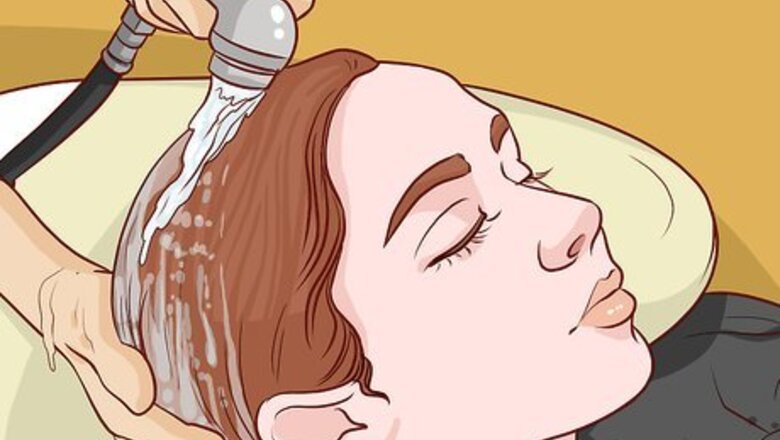
views
- Start by cutting clean, brushed hair with sharp scissors at the back-center of the hair. This will serve as your guide as you make your way toward the sides and front.
- Trim the sides to the length of the guide piece you cut at the back of the head. Move your guide piece to either side of the head as you trim your way around.
- Check that all hair is the same length by bringing all the hair to the front and smoothing it down flat. If a piece is a bit longer, simply trim it to match the rest.
Trimming Hair
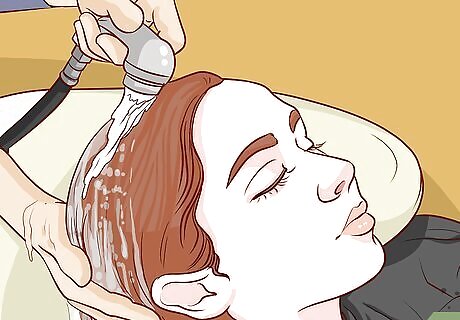
Start with washed hair. The hair should be clean and damp when cutting. After the hair is washed, towel dry it to remove excess water, and then comb out any knots. Comb from the ends, and work your way up to the root to work out knots. This will prevent damage to the hair and will put less strain on the scalp. You should always use a comb for detangling. Don't use a brush.
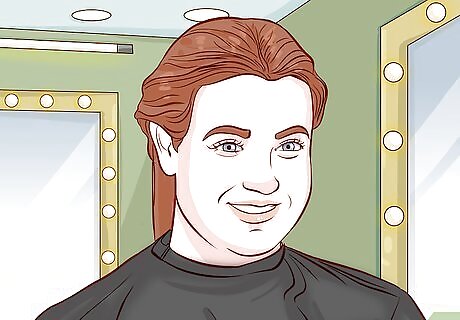
Sit in proper lighting. For a quality haircut, you will need to be in a well lit area. The girl who is getting the haircut needs to be sitting down straight, preferably in a chair high enough so the stylist does not need to lean down.
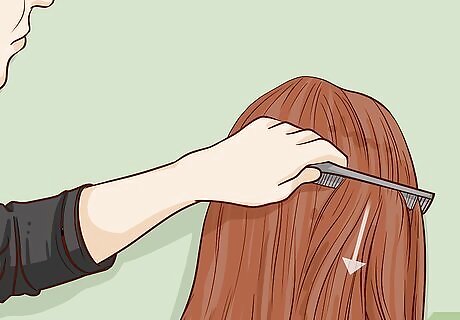
Comb the hair. The hair should be combed straight back first, and then parted in the place it normally is. If the hair is worn with a middle part, do that. If the hair has a side part on the left or right side, do that. The hair will typically fall where it is trained to be. Check behind the ears for snarled or stuck hair. All of the hair needs to be combed straight down for a proper cut.
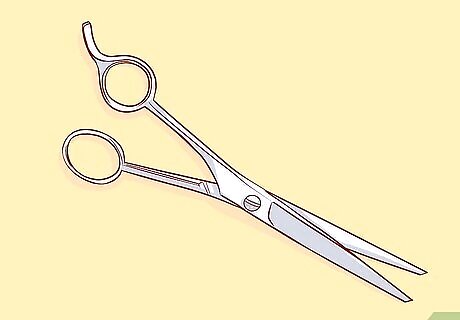
Use sharp scissors. The ideal scissors to use would be stylist scissors specifically designed for hair cuts. Dull scissors will not cut the hairs cleanly, and they might create split ends. Additionally, dull scissors will bend or push the hair down before making a cut, resulting in a hairline that looks uneven.

Start cutting in the back at the center. This will serve as your guide as you make your way towards the sides and front. You will use the back piece as a reference as you are cutting around the sides to keep the trim even. Pull up the back section of hair, and bring the ends through your forefinger and middle finger. You should have about 1/2 inch to two inches sticking out from your fingers. Cut straight across. For a softer look, you can trim up into the hair, holding the scissors at a 45 degree angle. The amount of hair you cut depends on how far up the damage goes, but typically it will be about 1/2 inch to two inches. Start by cutting less, and then go back to cut more if desired. Have the person lean their head forward slightly when cutting the back to help you perform a more even trim.
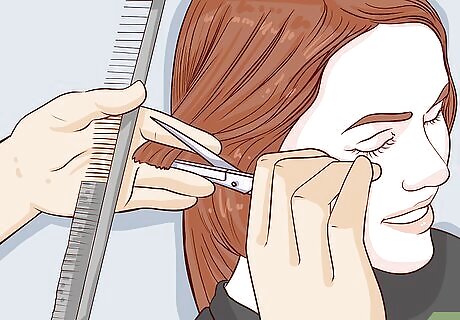
Trim the sides. Work your way from your guide piece to the side. When cutting the hair that lays on the shoulder, have the person slightly lean their head to the opposite side. This will bring the hair up to help you cut more evenly.
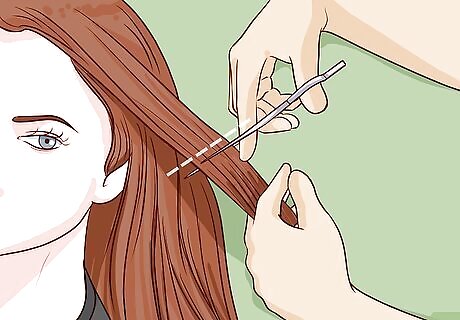
Cut the opposite side. Once you make it to the front of one side, go back to your guide piece in the back, and begin cutting the opposite side. Have the person lean their head to the opposite side you are cutting, and be sure to reference the guide piece the entire time.
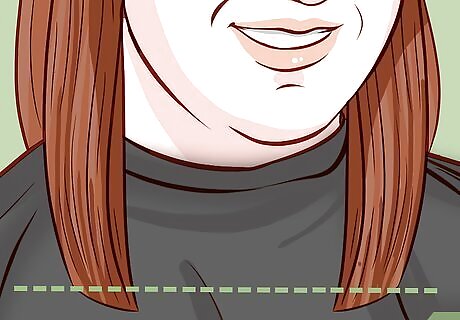
Check the length on both sides. Once you are finished, come to the front, and bring the hair from both sides between your fingers. Pull them down and flat, and look to see if they are the same length. If one side or piece is longer, go ahead and trim it appropriately. If you're cutting their hair in front of a mirror, it's easier to check the evenness by standing behind the person and looking at their reflection in the mirror.
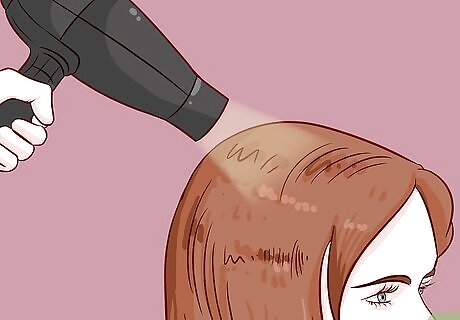
Finish the cut with a blow dry. Remember, as the hair dries, it will slightly shorten. If you notice any uneven pieces after the hair is dry, dampen the area, and even it out with scissors.
Cutting Layers
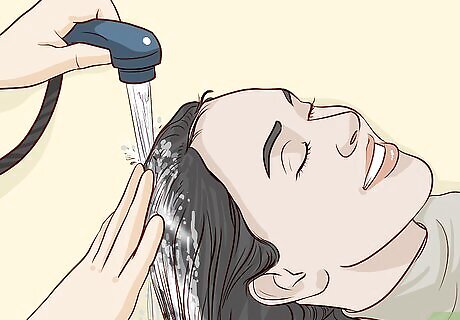
Wash and towel dry the hair to be cut. The hair should be clean and damp while it is being cut. Comb all of the tangles out, and apply leave in conditioner if needed. Decide on the length you want your hair to be before it is pinned up.
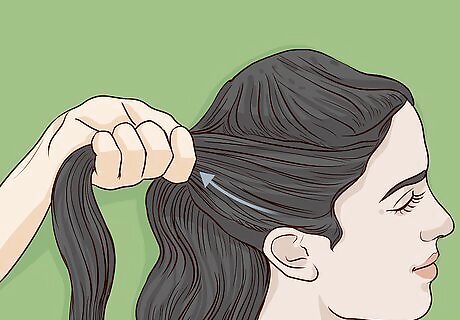
Divide the hair into sections. The layers on each side should be the same length, and to help do this, it is important to divide each side into symmetrical sections. The trick is to pull away from the places you want layers by combing each section at an angle down towards the face from the back. Here are the sections you will pin: As you divide your sections, twist each 1 into a tiny bun. Then secure the bun with a duckbill hair clip until you're ready to cut that section. Pin together the "top box" section. Use a comb to make a part on the top left and right side. Use the end of the eyebrows as a guide for how far over the part should be. Divide this section in half. One part will be from the crown of the head to the forehead, and the second part will be from the crown of the head and reach to the middle back section of your head. This hair will be combed forward and be section off in the front. The back of the hair from the middle down will not be layered. It can be left loose or pinned back. Divide the right and left front sections. These sections will start at the temples and end at the ear. Start with the comb at the back of the head, and angle down towards the bottom of the ear.
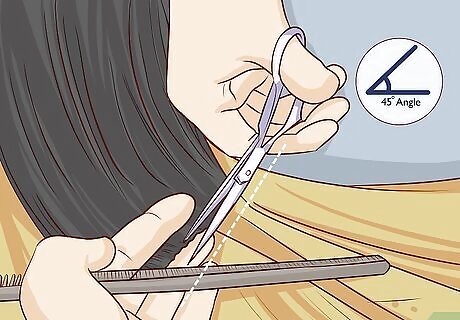
Angle your cuts. When you cut or trim hair, you will angle the scissors up and at a 45 degree angle, and use the tip of the scissors to cut small pieces at a time. This will create uneven edges that will give the hair a more natural look. As you are cutting, you want to avoid bringing the scissors straight across the bottom. Instead, slightly pull the scissors away after each cut before cutting the next piece.
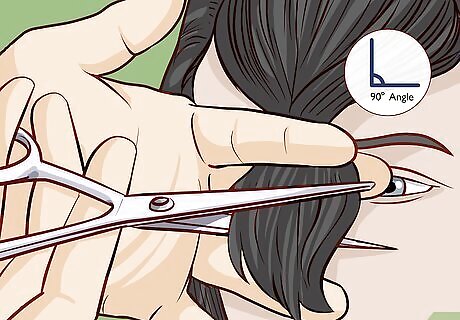
Start with the front "top box." Take out the clip from the top front section. Make sure the hair is still damp and completely combed out. Lift the hair at a 90 degree angle to your head, holding it between your forefinger and middle finger. It is important to cut the hair at an angle so it falls more naturally. Slide your fingers toward the ends until they reach the length you want the layer to end. You will cut the hair that is sticking out from your fingers. Cut a little longer than you want the layers to be to allow room for error. Keep in mind that hair shrinks when it dries. Common layers are cut right below the earlobe, or just above the jawline to help frame the face. It's a good idea to drop 1 section of hair down, and then cut it at the desired length of the layer. Then, you can pull that hair back up and use it as a guide for the rest of your hair.
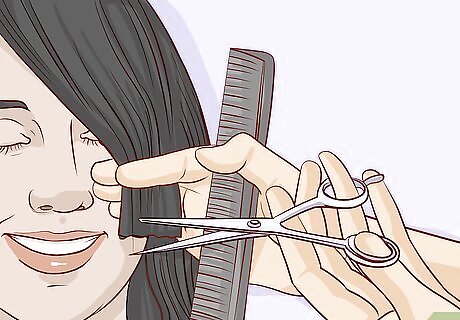
Trim the front left section. Next, take out the clip from the left section of hair. Brush through the hair, and pull it up toward the top section. Allow some of the hair to fall away so that you can maintain some of the longer length. Holding the left section between your fingers, trim the hair to your desired length. Remember to trim at an angle to create a more natural look. If necessary, you can always trim some of the fallen hair to add to your layer.
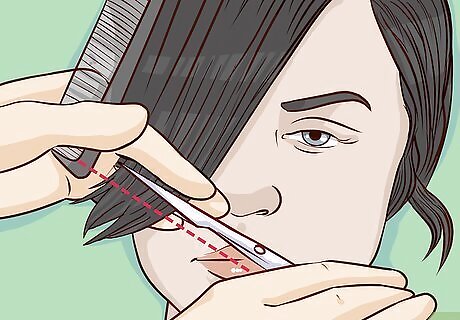
Cut the front right section. Next, take out the clip from the right section of hair. Brush through the hair, and run your fingers through the section at a 90 degree angle from the head. Bring your fingers down to the side of the face where you want the layer to end. Make sure it is even with the side you just cut. Use one hand to pull the layer that was just cut down so you can match up the two sides. When you are ready, cut the hair extending from your fingers.
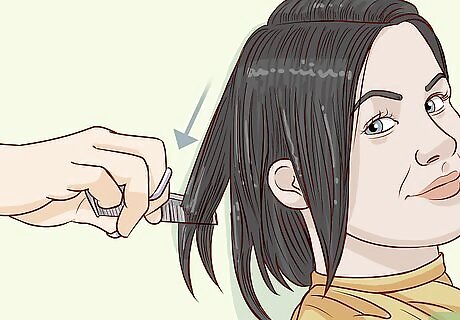
Comb through the hair. When you are finished with each section, check the length of the layers. Line them up on both sides to see if they are symmetrical. If one side or piece is shorter than the other side, go back and trim it shorter. When you make adjustments, take off small amounts at a time so you don't end up making the hair shorter than desired.
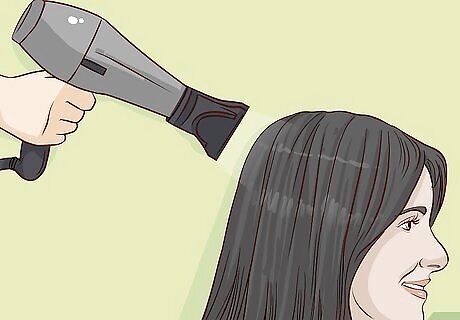
Blow dry the hair. Use a round brush as you blow dry to bring out the layers. Twist the brush inward as it dries to bring the shorter layers in with the longer layers. If you notice an area that needs to be cut shorter, remember to get all of the hair damp again before you cut it. If you only dampen one side, you will not be able to properly match up each side because the wet hair will appear longer than it will be once it dries.
Cutting Bangs
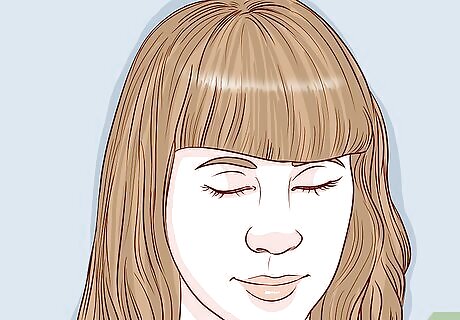
Prepare your bangs. Whether you are trimming bangs, or creating bangs for the first time, the front section of hair should be dry and combed out before cutting. Use a comb to section off only the area you wish to cut, and put the rest in a ponytail or clipped out of the way.> Your bangs should not extend further than your brow line. Also, they'll look best if they follow a triangle pattern with the top point being in the center of your hair about 3 inches (7.6 cm) above the bottom of your hairline. A common problem when cutting bangs is cutting them too short. This is why bangs are best cut when hair is dry. Cut the bangs longer than you ultimately want them. This way, you can figure out the shape you want, and go back to make adjustments.
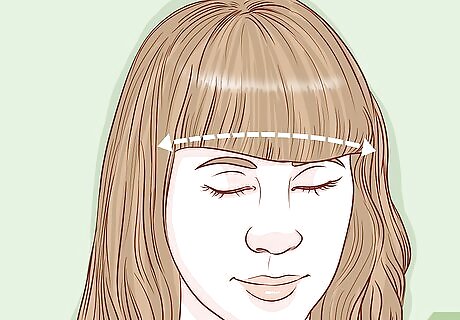
Cut at a curve. Bangs are not cut straight across. Instead, they curve down towards the temples to help create a frame for the face. However, it depends on the look your are going for.
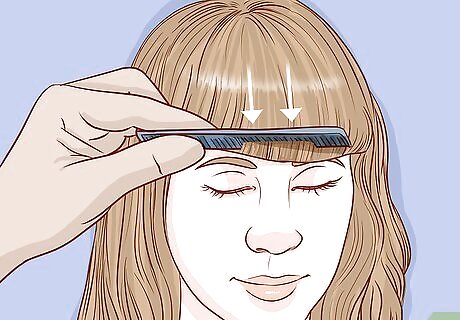
Gather the hair. If you are simply trimming bangs, you will bring the comb through underneath the bangs where you want them to end. If you are making new bangs, use the comb to section off the hair you want to cut. Depending on how thick the hair is, bangs usually start right in front of the middle of the crown and angle downward on both sides towards the temples. You can play around with the look you prefer.
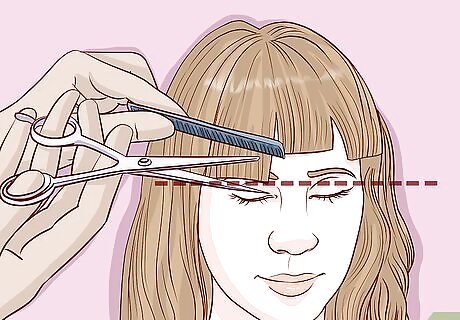
Cut in the middle. Make a straight cut across your forehead, directly below the comb. Work your way toward one side, following the curve. By starting in the middle, you will have more control over how short the bangs end up. Angle the scissors down when working your way to the edge to create a gradual curve. Once you have one side finished, bring the scissors back to the middle, and cut the other side.
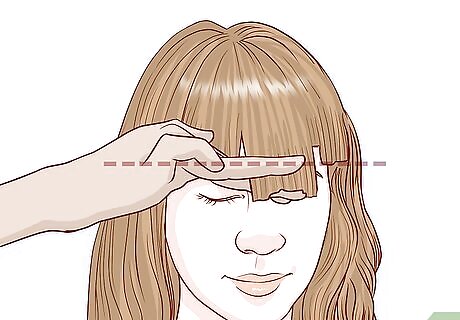
Check for symmetry. Use your finger tips to pull down on the hair between your forefinger and middle finger. See if the bangs are the same length on each side. If they are not even, carefully trim the side that is longer. Cut tiny amounts at a time so you do not accidentally cut the longer side shorter, which may result in bangs that are shorter than you want.
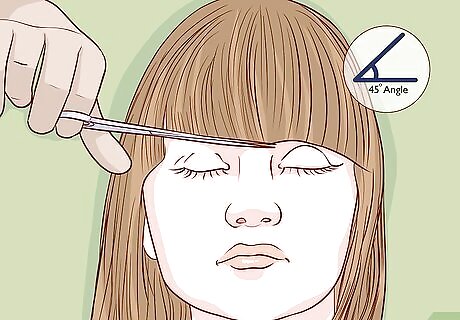
Soften the edges by cutting at a 45 degree angle. After your bangs are even, hold the scissors vertically at a 45 degree angle. Trim the edge with tiny cuts up into the hair, softening the look. Be careful not to remove any of the length.
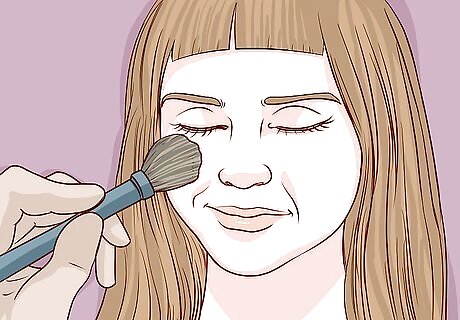
Sweep away cut hair. Use a makeup brush or blow dryer to get rid of those tiny trims. If the bangs do end up shorter than you were going for, do not worry. Hair grows at a rate of 1/2" per month on average, and that makes a big difference when it comes to bangs.




















Comments
0 comment